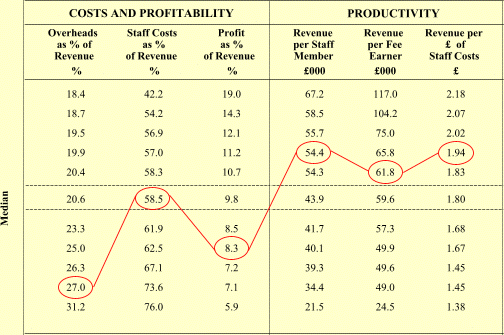
Benchmarking and Interfirm Comparison
Benchmarking can be defined as the regular
measuring and comparing of a company's performance both against its competitors
and against industry leaders. The aim is to learn how it can improve its own
performance.
Benchmarking can be used to examine any aspect of an organisation's performance whether it is in a manufacturing or service industry, a profession or the public sector. Functions, too, such as purchasing, stock control, customer service and marketing performance have all been successfully benchmarked.
The Centre for Interfirm Comparison has carried out benchmarking projects for over fifty years (the Centre was set up in 1959) and we have worked successfully in most sectors of the economy and in many countries throughout the world.
 The
sign at the right which you may have seen chiselled into the stonework of old
buildings is the original benchmark used
by British surveyors to record exact height above sea level. The term is used
nowadays to describe one of the most effective means of improving company performance.
The
sign at the right which you may have seen chiselled into the stonework of old
buildings is the original benchmark used
by British surveyors to record exact height above sea level. The term is used
nowadays to describe one of the most effective means of improving company performance.
We are the world leaders in competition benchmarking, sometimes called interfirm comparison
Interfirm comparison is a co-operative activity based on detailed information that has been provided - in absolute confidence - by participating firms on a comparable basis. At the outset we discuss with companies what information should be included, exactly how each item is to be defined and we identify any differences in company practices that should be taken into account. As a result, the data are properly comparable.
Typically about one hundred different ratios are used. They are shown in full for each company anonymously, using code letters. By comparing your ratios with those of others you can assess your performance against objective standards and see where you are weak and where you are strong.
The Centre's interfirm comparisons are of real practical value. We ask the right
questions, we choose the right ratios and we interpret the results so you can
take the action that is needed to improve your performance.
Firm D is a medium-sized professional firm. In the diagram the individual results of each firm are shown for six key ratios from the interfirm comparison. They are arranged in such a way that the 'best' results all appear at the top of the chart, the 'worst' at the bottom. Firm D's results have been ringed and linked to form a profile of its results. Profit margin is influenced mainly by the two ratios on the left. Staff costs are at the median level whilst overheads are the second largest figure. On the productivity side, all the firm's ratios are comparatively strong. Revenue earned per £ paid out in staff costs is £1.94, a little short of the most successful firms which are achieving at least £2.00. The clear message for Firm D is firstly to control the level of its overheads - and the detailed tables show the firm exactly where - and secondly to improve further the relationship between revenue earned and staff costs. They should consider cutting down slightly on the number of their employees, at least until revenue per fee earner is more competitive.

|
